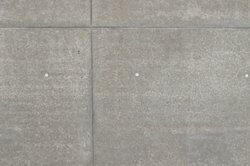Apply plaster to concrete
An unplastered wall can also become a stylistic device in your home design, but plaster is always common. A durable plaster layer can only be achieved on concrete if you observe the special features of this substrate. After all, you don't want the wall to crumble again after a short time.

Concrete is not just concrete
Concrete can have different properties. This may sound confusing to you at first, but it is an important thing for the application of the later layer of plaster.
- Bricks made of aerated concrete are highly absorbent. Her walls are also made of concrete, but the structure distinguishes it from the denser lightweight concrete.
- In the case of aerated concrete, steam pressure is used for production. There are also pore-forming substances. A lot of liquid can settle in these pores due to capillary action. You must take this into account when selecting the plaster preparation for the type of plaster.
- Lightweight concrete, on the other hand, is almost indistinguishable from normal concrete. Just like this one, it has almost no pores, a fine grain and is not very absorbent.
- Normal concrete has a well-closed surface that is hardly absorbent. Although this has advantages, it also has the disadvantage that the plaster does not easily stick to the wall.
- Before choosing the plaster, clarify which type of plaster is to be processed Underground consists. In the case of a new building, you can often find out about this in the building description or from the first previous owner. In other cases, a professional will help you.
Rotband plaster - this is how you apply the plaster correctly
For plastering and repairing damaged areas in the plaster, there is now a ...
Bring the plaster onto the wall
- Under no circumstances should you work without an adherent substrate layer.
- One option is to do a spray cast first. To do this, touch your plaster very thinly and throw it on the wall with a tassel like a modern artist.
- In this way, a network of thin lines and spots is initially created, which will later form an adhesive base for the actual plaster layer. However, do not create patterns that are too artistic, try to cover the surface evenly.
- You can also apply a primer. A primer suitable for your plaster and concrete is applied to compensate for the lack of absorbency of the concrete. You can get the right material from specialist retailers and well-stocked hardware stores.
- When using spray grout and adhesive bridges, always make sure that you follow the manufacturer's instructions for the material. You should also thoroughly prepare and clean the surface.
- The drying phase of the substrate on the concrete depends on the temperature and humidity. Do not shorten these times. The waiting time is worth it for a good and lasting end result.
How helpful do you find this article?

